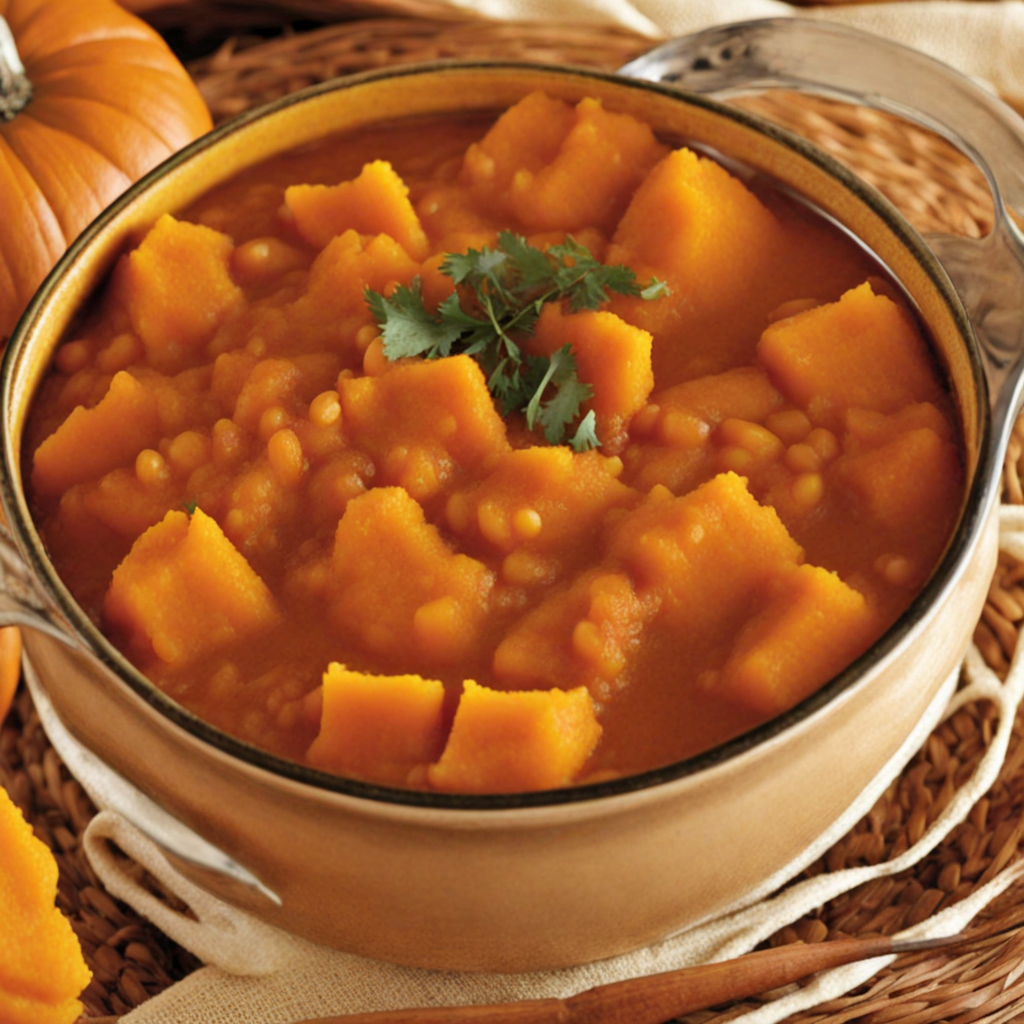Stewed Pumpkin
Stewed Pumpkin, or "Bokomo" as it is known in Eswatini, is a traditional dish that embodies the rich agricultural heritage of the region. This comforting dish features tender chunks of pumpkin that are simmered slowly until they reach a luscious, melt-in-your-mouth consistency. The natural sweetness of the pumpkin is enhanced through the cooking process, creating a harmonious balance of flavors that captures the essence of Eswatini's vibrant culinary landscape. Often seasoned with a pinch of salt and sometimes a hint of cinnamon, the dish offers a delightful contrast between sweet and savory, making it an enticing option for both the palate and the soul. In Eswatini, stewed pumpkin is commonly prepared using locally sourced ingredients, which adds to its authenticity. The pumpkins are typically harvested during the harvest season, ensuring that the dish is made with fresh, in-season produce. The cooking method often involves a simple pot over an open flame, allowing the pumpkin to stew gently, absorbing the warmth and flavors around it. This rustic approach not only preserves the nutritional benefits of the pumpkin but also infuses the dish with a smoky undertone that elevates its taste. Served as a side dish or as part of a larger meal, Stewed Pumpkin is frequently enjoyed alongside staples like maize porridge or rice. It is a dish that reflects the communal spirit of Eswatini, often shared among family and friends during gatherings or celebrations. The vibrant orange hue of the pumpkin not only makes for an inviting presentation but also signifies the warmth and hospitality of the Swazi people. For anyone looking to explore new flavors, Stewed Pumpkin offers a delightful taste of Eswatini's culinary traditions, inviting you to savor the simplicity and depth of this beloved dish.
How It Became This Dish
Emabhontjisi: A Culinary Jewel of Eswatini #### Origins Emabhontjisi, a traditional dish from Eswatini (formerly known as Swaziland), is a delightful reflection of the nation’s vibrant culture and agricultural practices. The dish, characterized by its use of maize meal, is often enriched with ingredients like pumpkin, beans, or vegetables, forming a savory porridge or thick stew. Its name derives from the siSwati word for "pumpkin," highlighting the key ingredient in many variations of the dish. The origins of Emabhontjisi can be traced back to the indigenous agrarian communities of Eswatini, where maize, a staple crop, has been cultivated for centuries. Maize was introduced to Southern Africa by Portuguese explorers in the 16th century, and it quickly became a fundamental part of the local diet. The adaptation of maize into various local dishes reflects the resourcefulness of the Swazi people in maximizing their agricultural outputs and culinary creativity. In this context, Emabhontjisi emerged as a practical and nourishing food, suitable for the demands of daily life. #### Cultural Significance Emabhontjisi is more than just a meal; it represents a deep connection to Swazi culture and identity. Food in Eswatini is often intertwined with social and communal practices, serving as a means of bringing families and communities together. Emabhontjisi is commonly prepared for special occasions, such as weddings, harvest festivals, and community gatherings, where it is enjoyed alongside other traditional dishes. In Swazi culture, the act of preparing and sharing food is a ritual that conveys hospitality and kinship. Emabhontjisi is often served in communal bowls, encouraging diners to share and foster bonds. The dish embodies the spirit of togetherness, as families gather around a meal to celebrate life’s milestones and daily achievements. Its preparation is typically a communal effort, with women often taking the lead in cooking and men contributing by gathering ingredients or tending to the fire. Moreover, Emabhontjisi plays a role in the celebration of Swazi identity and heritage. As globalization continues to influence eating habits and food practices, maintaining traditional dishes like Emabhontjisi is vital for cultural preservation. It serves as a reminder of the historical connections between the land, the people, and their food. #### Development Over Time Over the years, Emabhontjisi has evolved while maintaining its core essence as a comfort food in Eswatini. Historically, it was primarily a sustenance dish made with readily available ingredients. However, with the introduction of new cooking techniques and the influence of globalization, the dish has seen variations that reflect both modern tastes and traditional roots. In its traditional form, Emabhontjisi was often prepared using simple techniques passed down through generations. Maize meal was mixed with water and cooked over an open flame, sometimes enhanced with pumpkin or beans for added flavor and nutrition. The dish was typically seasoned with local spices and served alongside meat or vegetables, making it a well-rounded meal. As Eswatini became more integrated into the global food landscape, influences from neighboring countries and international cuisines began to shape the preparation of Emabhontjisi. Contemporary Swazi cooks have experimented with different ingredients, introducing flavors such as garlic, herbs, and spices that were not traditionally used. The use of modern cooking appliances, like electric stoves and pressure cookers, has also altered cooking times and methods, allowing for greater convenience while still honoring traditional flavors. The rise of urbanization and changing lifestyles have led to a shift in how Emabhontjisi is consumed. In urban areas, where traditional farming practices may be less common, the dish has found its place in restaurants and food markets, making it accessible to a broader audience. This commercialization has not only helped to sustain the dish but has also introduced it to tourists, who may seek authentic culinary experiences when visiting Eswatini. Despite these changes, the core values associated with Emabhontjisi remain intact. It continues to be a symbol of Swazi hospitality and community, often served to guests as a show of respect and generosity. Families still gather to prepare the dish, reinforcing the communal aspects of its consumption. #### Nutritional and Economic Importance In addition to its cultural significance, Emabhontjisi holds nutritional value, particularly as a source of carbohydrates, fiber, and essential vitamins. The incorporation of pumpkin and beans further enriches the dish, making it a balanced meal that supports the health of families in Eswatini. This aspect is particularly important in rural communities, where access to diverse foods may be limited. Economically, Emabhontjisi contributes to local agriculture. The cultivation of maize and pumpkins provides income for many farmers, and the dish itself can be a source of livelihood for those who sell it in local markets or restaurants. By supporting local agriculture and food systems, Emabhontjisi plays a role in sustaining the economy of Eswatini and promoting food security. #### Conclusion Emabhontjisi is a culinary gem of Eswatini, encapsulating the rich history, cultural significance, and evolving nature of Swazi cuisine. From its humble origins as a sustenance food to its place on the tables of families and in restaurants, this dish tells a story of resilience, community, and identity. As Eswatini continues to navigate the complexities of modernity and tradition, Emabhontjisi stands as a testament to the enduring power of food in connecting people to their heritage and to one another. In celebrating Emabhontjisi, we embrace not only a delicious dish but also the stories, traditions, and values that continue to shape the culinary landscape of Eswatini.
You may like
Discover local flavors from Eswatini







